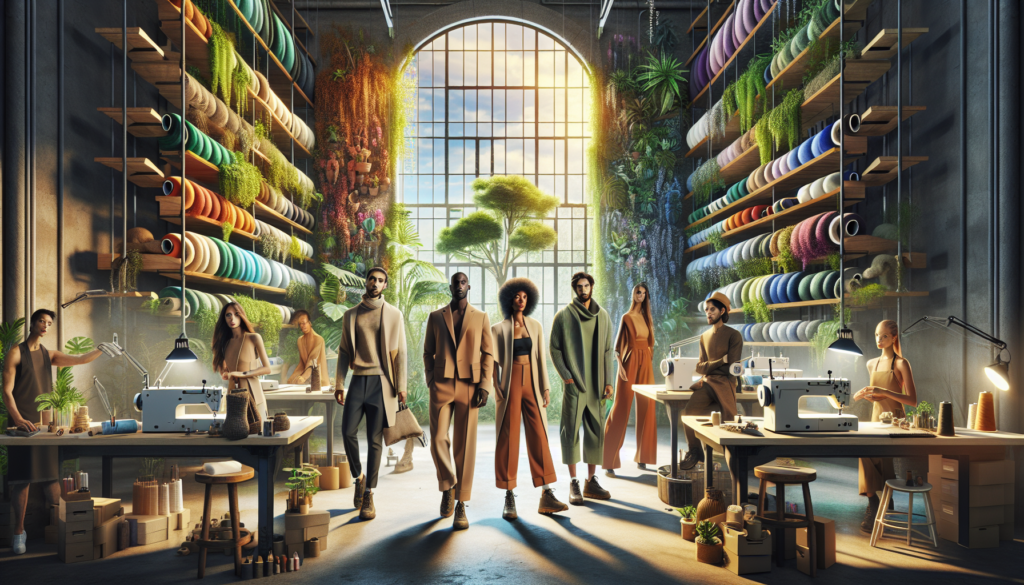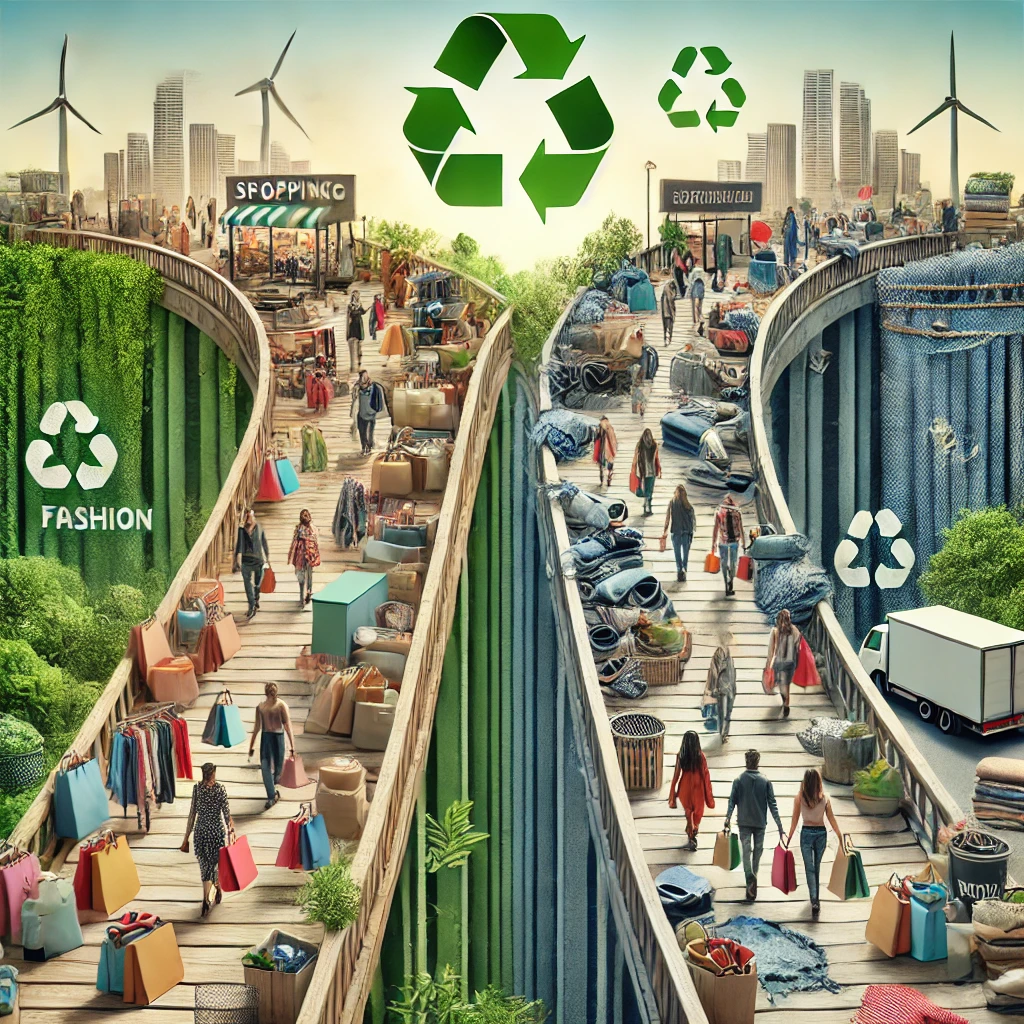The fashion industry is undergoing a remarkable transformation as sustainable fashion takes centre stage. With growing consumer awareness about the environmental impact of fast fashion, brands and designers are embracing innovative approaches to create eco-friendly clothing. This shift has an influence on every aspect of the fashion ecosystem, from sourcing materials to manufacturing processes and even how we shop for and care for our clothes.
As we look ahead to fashion trends in 2024 and beyond, sustainable development in the industry is gaining momentum. Circular economy principles, the use of recycled materials, and the rise of second-hand clothing markets are reshaping the landscape. Despite these positive changes, challenges remain. The industry still grapples with issues like overproduction, waste management, and the need for more transparent supply chains. This article explores the progress made in sustainable fashion, the hurdles that lie ahead, and the collaborative efforts needed to drive lasting change.
The Rise of Sustainable Fashion
Growing consumer awareness
In recent years, sustainable fashion has gained significant momentum as consumers become increasingly aware of the negative impact of fast fashion on the environment and society. This shift in consciousness has led to a growing demand for eco-friendly and ethical alternatives, pushing brands to prioritise sustainability in their practises . As a result, consumers now have more options to make conscious fashion choices that support a better future for the planet and its people .
The fashion industry’s environmental footprint has become a major concern, with the sector accounting for approximately 10 percent of global carbon emissions, surpassing both international flights and maritime shipping combined . This startling statistic has prompted many consumers to seek out sustainable and ethical alternatives, moving away from fast fashion .
Adoption of eco-friendly materials
To meet the rising demand for sustainable fashion, brands are embracing eco-friendly materials and production methods. Many companies are now using sustainable materials like organic cotton, recycled polyester, and Tencel in their products . These materials have a lower environmental impact compared to conventional alternatives and help reduce the industry’s carbon footprint.
One innovative example is the Q-NOVA yarn by Fulgar, which is made from waste materials from the company’s main production cycle . Another noteworthy innovation is the Q-Cycle yarn, produced through pyrolysis as part of the ChemCycling™ project. This yarn transforms scrap tyres into a new resource, reducing the need for fossil raw materials and offering significant benefits in terms of reduced CO2 emissions – around 40% less than a textured Fulgar nylon yarn made from virgin polymer .
Circular fashion initiatives
Circular fashion has emerged as a key concept in the sustainable fashion movement. This approach involves creating a closed-loop system where materials are reused and regenerated, minimising waste and extending the life cycle of clothing . Several initiatives are driving this circular economy in fashion:
- Clothing rental services: This system allows people to borrow clothes for a specific period, reducing the need for constant production and promoting sharing among consumers .
- Second-hand markets: Thrift stores and online platforms for pre-owned clothing extend the life cycle of garments and prevent them from ending up in landfills .
- Remaking and upcycling: Companies are finding innovative ways to transform old or discarded materials into new garments, reducing waste and creating unique pieces .
- Repair centres: Some brands are establishing repair centres to fix minor damages or make style adjustments, extending the lifespan of clothing items .
- Take-back programmes: Extended Producer Responsibility (EPR) initiatives allow customers to return products to brands for recycling, disposal, or repurposing .
These circular fashion initiatives are not only reducing waste but also creating new business opportunities. In Europe, circular-economy product segments are projected to increase in market size by 10-15% by 2030, representing an estimated €400 billion to €650 billion annual opportunity for European companies .
As the sustainable fashion movement continues to grow, it’s clear that both consumers and brands have a crucial role to play in driving positive change. By making informed choices and supporting eco-friendly practises, we can work towards a more sustainable and responsible fashion industry.
Key Innovations Driving Progress
Recycled and Upcycled Fabrics
The fashion industry is embracing innovative approaches to reduce waste and promote sustainability. Upcycling, a practise that has existed for years in furniture and household items, is now gaining traction in fashion production. This technique involves repurposing waste materials to create new garments, offering an alternative to mass production .
There are two types of waste commonly used in upcycling: pre-consumer and post-consumer waste. Pre-consumer waste includes excess material or textile scraps that can be repurposed into new outfits, while post-consumer waste refers to items that have been bought, used, and then given away, such as donated clothing .
The benefits of upcycling are significant. It helps reduce the estimated 10,000 items that go to landfill every five minutes, significantly decreasing the fashion industry’s environmental impact . Moreover, upcycling can help reduce CO2 emissions, as the fashion industry currently produces around 8-10% of global emissions .
Experiments have shown that 50% of fabric leftovers from garment manufacturing can be upcycled into new garments, with some types of leftover material – mainly spreading loss and excess fabric – reaching up to 80% upcycling potential .
Waterless Dyeing Techniques
The textile industry has been a major consumer of water, with an estimated 100-150 litres of water required to process one kilogramme of textile material . Dyeing contributes to 15-20% of total water wastage and is a significant source of water pollution .
To address these issues, innovative waterless dyeing techniques have been developed. One such method is DyeCoo, which uses CO2 for dyeing purposes. This technology eliminates the use of water and processing chemicals, leading to a reduction in energy consumption. Each DyeCoo machine can save 15 million litres of water and 6,500 kg of processing chemicals annually .
Another groundbreaking technique is AirDye®, where dyes are passed into fabrics in a gaseous state by opening the fibre structure. This method allows for better dye penetration and can even colour both sides of a fabric with different colours simultaneously .
The Greendye technology, launched by Karl Mayer, is used for dyeing jeans without water and with 50% fewer chemicals. It increases the amount of dye pickup by three times compared to conventional dye vats .
3D Knitting and Printing
3D knitting is an emerging production technique that has been gaining attention in the fashion industry. This method involves computer-programmed knitting machines constructing entire garments in a three-dimensional structure, eliminating the need for cutting and sewing pieces together manually .
The advantages of 3D knitting are numerous. It reduces inventory costs and excess stock for on-demand products, decreases textile waste by 30%, and increases productivity levels. The technology also allows for a faster response to market trends and reduced energy consumption, with 43% less electricity used compared to conventional knitting .
3D knitting offers opportunities for customization and personalization, potentially leading to consumers feeling more attached to their garments and keeping them longer, thus increasing their lifecycle .
While 3D knitting technology presents challenges, such as high initial investment costs and the need for specialised training, its potential to revolutionise garment production and contribute to sustainability makes it a promising innovation for the future of fashion .
Persistent Challenges in the Industry
Fast fashion culture
The fast fashion industry has revolutionised the retail sector, but not necessarily for the better. This model, characterised by rapid design, production, and distribution of clothing, has created a culture of ‘disposability’ among consumers. In the UK, brands like Pretty Little Thing, Boohoo, and Primark have been at the forefront of this phenomenon, offering affordable clothing that aligns with the latest trends .
The appeal of fast fashion lies in its ability to quickly deliver trendy styles seen on runways, red carpets, and social media influencers. However, this rapid turnover of trends has led to a concerning pattern where clothing items are often worn only a handful of times before being discarded . This culture of overconsumption has significant environmental consequences.
Online platforms and social media play a crucial role in perpetuating this cycle. Platforms like Instagram and TikTok serve as virtual runways, creating a sense of urgency to stay on-trend and leading to impulse purchases . The environmental impact of this consumption pattern is staggering. The fashion industry is responsible for about 10% of global carbon emissions, surpassing both international flights and maritime shipping combined .
Complex global supply chains
The complexity of fashion supply chains presents a significant challenge in the industry’s pursuit of sustainability. Most supply chains are intricate, but in the fashion industry, this complexity is extreme. The tiered nature of these supply chains means that each supplier engages with suppliers of their own, resulting in a network comprising multiple tiers .
This complexity makes it difficult for brands to map their entire supply chain accurately. As Leonardo Bonanni explains in McKinsey’s 2019 State of Fashion report, “An apparel company might think that they only have 1,000 to 2,000 suppliers, but the reality is they have 20,000 to 50,000 when you count all the sub-suppliers” . This vast network makes supply chain management challenging, especially when trying to incorporate environmental performance metrics.
Cost barriers to sustainability
Integrating sustainable practises into the fashion industry comes with significant financial hurdles. The upfront costs of setting up a sustainable supply chain network can be particularly high for smaller companies . These costs often impact the price of the product, making it difficult for some companies to justify to customers who may not be sufficiently aware of the importance of sustainability .
Moreover, the fast-paced nature of the fashion industry adds another layer of complexity. The industry’s short product cycles and rapidly changing market demands mean that supply chain needs change quickly. Brands focused on managing their environmental impact must evaluate potential suppliers from a sustainability perspective, in addition to traditional factors like quality and cost . This additional consideration can be challenging to maintain consistently, especially under time and cost constraints.
Despite these challenges, it’s important to note that ‘greener’ practises don’t always mean ‘more expensive’. Many companies find that switching to environmentally responsible suppliers and eco-friendly materials can have a positive impact on their bottom line. Additionally, conducting thorough life cycle assessments and supply chain analyses often reveals opportunities for increasing efficiency and cutting costs .
The Way Forward: Collaboration and Policy
Industry-wide partnerships
The fashion industry is recognising the need for collective action to address sustainability challenges. Brand collaborations centred around sustainability can deliver strong commercial benefits while driving positive change across the sector . These partnerships allow companies to leverage each other’s strengths and accelerate the adoption of better practises. For instance, the collaboration between Reformation and New Balance generated a waiting list of over 11,000 customers and featured on Lyst’s top collaborations of 2019 .
Sustainable brand partnerships also provide opportunities for knowledge-sharing between businesses. By combining the expertise of smaller pioneering brands with the resources of larger companies, innovations in social and environmental practises can be scaled up more effectively . This approach has the potential to transform how established fashion houses think about waste materials and sustainable production methods.
Government regulations and incentives
As voluntary measures have proven insufficient, there is a growing call for stricter regulations in the fashion industry. Policymakers are proposing legislation to hold brands accountable for their environmental and social impacts. For example, the Fashion Sustainability and Social Accountability Act in New York would require fashion companies with revenue exceeding £78.56 million to map at least half of their supply chains . Non-compliance would result in fines, creating financial incentives for adopting more ethical and sustainable practises.
Other proposed regulations include the EU’s Extended Producer Responsibility Scheme, which would require fashion brands to pay a ‘waste fee’ based on the circularity of their products . Additionally, the European Green Deal’s Corporate Sustainability Reporting Directive (CSRD) mandates major fashion corporations to report on ESG metrics using externally audited standards .
Consumer education initiatives
Empowering consumers through education is crucial for driving sustainable fashion forward. By promoting awareness and understanding, individuals can contribute to the movement through responsible consumption and proper clothing disposal . Consumer education initiatives can help shift the focus towards a circular fashion economy, emphasising the importance of making informed choices and demanding better practises from brands .
To maximise the impact of consumer education efforts, stakeholders should collaborate on developing comprehensive strategies. This approach can inspire change and push the industry toward a greener future while fostering a sense of shared responsibility among consumers, brands, and policymakers .
As the fashion industry continues to evolve, the combination of industry-wide partnerships, government regulations, and consumer education initiatives will be essential in creating a more sustainable and responsible future for fashion. By working together and implementing effective policies, the industry can address its environmental and social challenges while maintaining profitability and meeting consumer demands for ethical and eco-friendly products.
Conclusion
The sustainable fashion movement has gained significant momentum, reshaping the industry’s landscape. From the adoption of eco-friendly materials to circular fashion initiatives, brands and consumers are working together to reduce the environmental impact of clothing production and consumption. Innovations like recycled fabrics, waterless dyeing techniques, and 3D knitting are paving the way for a more sustainable future in fashion. These advancements not only help to cut down on waste and resource use but also open up new possibilities for creativity and customization in the industry.
Despite this progress, challenges remain, particularly in addressing the fast fashion culture and untangling complex global supply chains. To overcome these hurdles, collaboration between industry players, policymakers, and consumers is crucial. Through industry-wide partnerships, government regulations, and consumer education initiatives, the fashion sector can continue its journey towards sustainability. As we move forward, the focus must remain on balancing environmental responsibility with commercial viability, ensuring that sustainable fashion becomes the norm rather than the exception.
FAQs
What are the main sustainability challenges facing us in 2023?
In 2023, cost remains a significant barrier to achieving greater sustainability. Additionally, the absence of established standards and practical tools hinders the adoption of sustainable practises. Efforts like the RICS’ WCLA are being developed to tackle these issues.
What obstacles does the fashion industry face in becoming more sustainable?
The fashion sector struggles with several sustainability challenges, including the need to decrease water and energy use, minimise waste, and cut down on greenhouse gas emissions. Despite notable advancements towards sustainability, there remains considerable scope for further improvements.
What are the key sustainability trends in fashion for 2023?
In 2023, fashion is seeing a strong trend towards upcycling and recycling, which are pivotal in reducing waste and fostering a circular economy. Upcycling involves repurposing old or discarded clothing into new, valuable items, thereby reducing textile waste and providing consumers with unique, sustainable fashion choices.
What makes sustainable fashion challenging to implement?
The adoption of sustainable fashion is complicated by the high costs and limited availability of sustainable materials. Moreover, sustainable production techniques, such as non-toxic dyeing, regenerative farming, and reduced water usage, further escalate costs. Many brands committed to sustainable fashion are also keen to support ethical labour practises.




